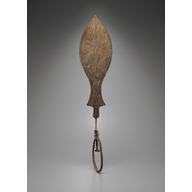Provenance Information
The work was reportedly found in the early 1960’s with five similar works near Faza, 75 kilometers southeast of Shiraz in the province of Fars in Iran. According to Roman Ghirshman, who published the work in 1963, the work was once in the Azizbeghlou collection in Tehran, Iran, but was sold before 1963. In 1966, the work was exhibited at the Musée Rath in Geneva, Switzerland and the catalogue accompanying the exhibition noted that the work was in a private collection. The Metropolitan Museum believes, but does not have independent confirmation, that the private collection was that of Charles Gillet, who died in 1966, or his partner, Marion Schuster, both of Lausanne, Switzerland. Marion Schuster apparently inherited all or most of Charles Gillet’s collection upon his death. When Marion Schuster died, one of her daughters, Mathilde de Goldschmidt Rothschild, who lived in Europe, inherited the work. On July 10, 1989, the work was sold at a Sotheby’s auction in London, Antiquities from the Collection of the Late Madame Marion Schuster, Lausanne and by Descent the Property of Madame Mathilde de Goldschmidt Rothschild, as lot 59. In 1992, the work was sold by Robin Symes to Bodo Schöps, who, in 2004, transferred ownership to the Exartis Foundation. The Exartis Foundation then transferred ownership to Mrs. Hiroko Horiuchi who, in 2010, transferred ownership to Mr. Noriyoshi Horiuchi, from whom The Metropolitan Museum of Art acquired the work.
Exhibition Information
In 1966, the work was exhibited at the Musée Rath in Geneva, Switzerland and was also exhibited in connection with the Sotheby’s auction in 1989. The work has been on loan to The Metropolitan Museum of Art since 1999 and on display in the Museum’s Ancient Near East galleries since that time.
Publication Information
The work was first published in 1963 in Ghirshman, Roman, “Notes Iraniennes XII, Statuettes Archaïques du Fars (Iran).” Artibus Asiae 26, pp. 151-160. In 1966, the work was published in the catalogue accompanying Musée Rath exhibition. The work was published again in 1968 in Nagel, Wolfram, “Westmakkanische Rundplastik.” Berliner Jahrbuch für Vor- und Frügeschichte 8, pp.104-19. The work was also published in the Sotheby’s auction catalogue in 1989.
Section of the AAMD Guidelines relied upon for the exception to 1970
Informed judgement that works were outside of the country of modern discovery before 1970
Explain why the object fits the exception set forth above
The work has provenance established to the 1960’s. Although the Metropolitan Museum has been unable to confirm when the work left Iran on a permanent basis, the Metropolitan Museum suspects that the work was permanently outside Iran and in a Swiss private collection by 1966 since all parties associated with the work since 1966 were Swiss and lived in Switzerland or elsewhere in Europe. The work was published in 1963, 1966, 1968 and 1989, when it was sold at public auction. The work was on public display at the Musée Rath in Geneva in 1966, and has been on display at The Metropolitan Museum of Art since 1999. The work is one of six such sculptures known to exist and fulfills a crucial function in The Metropolitan Museum of Art’s collection by allowing the Museum to document an area of the ancient world that became known to archaeologists only a few decades ago.

